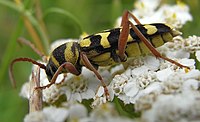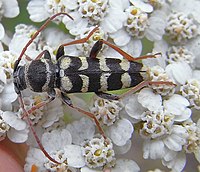Plagionotus floralis
| Plagionotus floralis | ||||||||||||
|---|---|---|---|---|---|---|---|---|---|---|---|---|

Plagionotus floralis on yarrow |
||||||||||||
| Systematics | ||||||||||||
|
||||||||||||
| Scientific name | ||||||||||||
| Plagionotus floralis | ||||||||||||
| ( Pallas , 1776) |
Plagionotus floralis ( synonym Echinocerus floralis , the genus name is still under discussion) is a beetle from the family of the longhorn beetle and the subfamily Cerambycinae . The species is found mainly in south-east Europe and rarely to very rare in south-central Europe. Therefore only the scientific name is used here. In areas where the beetle can become a pest, it is called "alfalfa buck".
The species is not listed in Germany's Red List of Endangered Species . In Brandenburg , Rhineland-Palatinate and Thuringia it is classified as extinct or lost .
Notes on the name
The species was first described in 1776 by Pallas under the name Cerambyx floralis . After the description, Pallas continues: Colligitur in floribus…. ( Latin was collected on flowers ...). This explains the species name "floralis" (lat. Living on flowers).
The generic name Plagionotus (from ancient Greek πλάγιος plágios, across and νότος nōtos, back) was created in two steps. First all Cerambyx species with a large, rounded breast shield without thorns were placed in the genus Clytus . Clytus was split up by Mulsant . The species that are defined by the prothorax transversely oval , at least one third wider than long, from the species with a longitudinally oval or rounded prothorax were assigned to the genus Plagionotus .
In Europe the genus Plagionotus is represented with eight species, worldwide with twelve species.
Characteristics of the beetle
The body is elongated and cylindrical. Its length varies widely and is between six and twenty millimeters.
The head is wider than it is long. The mouthparts point downwards. The middle of the forehead is slightly indented and without a keel. The eleven-link, red-brown antennae are strong and narrow towards the end. The middle antennae are edged out at the end and angularly drawn out. The kidney-shaped eyes only cover a small part of the antenna base from behind, the distance between the bases of the two antennae is smaller than the distance between the inner edges of the eyes (Fig. 2).
The pronotum is approximately spherical and almost as wide as the elytra . It is black and has a yellow cross band on the front edge and in front of the rear edge.
The black elytra are also banded transversely in pale yellow. The first "band" is formed by the yellow hairy label and the wide yellow hair spots next to it. In the first third of the wing coverts there is still a band that is pushed forward at the wing cover seam . The widest band follows shortly after the middle of the elytra. It is shifted backwards at the wing cover seam. Another transverse ligament lies in the third third of the elytra. Finally, the rear ends of the elytra are also hairy yellow.
The legs are red-brown and more robust than those of the species of the genus Clytus , the thighs are often darkened. The middle and hind legs do not have long protruding hairs on the underside as in related species (Fig. 4). The five-limbed tarsi appear to be four-limbed because the fourth limb is very small and hidden between the lobes of the third limb.
biology
The warmth-loving species can only be found in dry, warm places in Central Europe, for example steppe on sandy subsoil, also field margins on clayey subsoil. The larva develops in various herbaceous plants, in the stems or in the roots (e.g. alfalfa , yarrow , milkweed ). The life cycle is one year, at the northeastern border of the distribution area the development can take two years. The adult beetle appears in May and June. It can then be found on flowers, often on yarrow. The beetle, which is rare in Central Europe, can become a pest in other areas.
 Fig. 1: side view Fig. 3: white variant  |
 Fig. 2: Front view Fig. 4: Front central splint and mid tarsus, behind the hind leg  |
distribution
The distribution area of Plagionotus floralis extends from Spain far to the east, includes the Black Sea and Asia Minor . From Central Europe it only reaches the southern parts, old finds from Germany are questionable. There are permanent settlements in Austria. The current northern limit of distribution in eastern Central Europe currently runs through Lower Austria and South Moravia . In the east of the distribution area, the beetle also penetrates further north. It can also be found in northern Russia .
Individual evidence
- ↑ Hüseyin Özdikmen and Semra Turgut: A short Review on the Genus Plagionotus MULSANT, 1842 (Coleoptera: Cerambycidae: Cerambycinae) Mun. Ent. Zool. Vol. 4, No. 2, June 2009, as PDF
- ↑ Red lists at BioNetworkX
- ↑ PSPallas: travel through different provinces of the Russian empire. Zweyter Theil, second book from the year 1771 St. Petersburg 1773 at GDZ S. 358/724 No. 63
- ↑ Sigmund Schenkling: Explanation of the scientific beetle names (species)
- ↑ Sigmund Schenkling: Explanation of the scientific beetle names (genus)
- ^ E. Mulsant: Histoire naturelle des Coléoptères de France Paris 1862–1863 splitting of Clytus p.137
- ↑ Plagionotus in Fauna Europaea. Retrieved February 27, 2013
- ↑ Plagionotus at BioLib
- ↑ Teodora B. Toshova, Daniela I. Atanasova: Seasonal Activity of Plagionotus (Echinocerus) floralis (Pallas) (Coleoptera: Cerambycidae, Cerambycinae) Adults in Bulgaria Established by Attractant Baited Fluorescent Yellow Funnel Traps , Acta Phytopathologica et Entomologica Hungarica 45 (2) , pp. 391-399 (2010) doi: 10.1556 / APhyt.45.2010.2.17 .
- ↑ Plagionotus floralis in Fauna Europaea. Retrieved December 20, 2010
literature
- Heinz joy, Karl Wilhelm Harde, Gustav Adolf Lohse (ed.): The beetles of Central Europe . tape 9 . Cerambycidae Chrysomelidae . Spektrum Akademischer Verlag, Munich 1999, ISBN 3-8274-0683-8 (first edition: Goecke & Evers, Krefeld 1966).
- Adolf Horion: Faunistics of the Central European Beetles, Bd. XII . Überlingen-Bodensee 1974
- Klaus Koch : The Beetles of Central Europe . Ed .: Heinz Freude . tape 3 : ecology . Goecke & Evers, Krefeld 1992, ISBN 3-87263-042-3 .